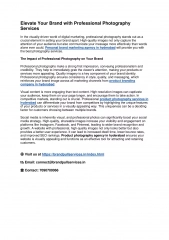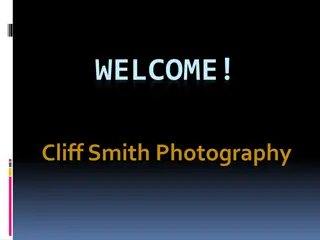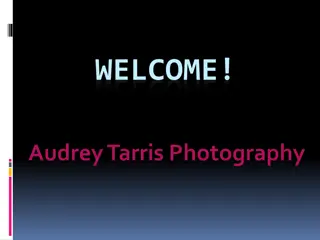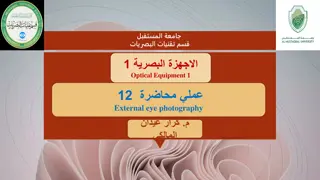Mastering Photography: Lessons in Visual Storytelling
Join Bradley Wilson, Ph.D., as he delves into the art of photojournalism in his series of lessons "Mastering Photography: Lessons in Visual Storytelling." From understanding lighting techniques to exploring the rule of thirds, this comprehensive guide will enhance your skills in capturing compelling images that tell impactful stories.
Download Presentation

Please find below an Image/Link to download the presentation.
The content on the website is provided AS IS for your information and personal use only. It may not be sold, licensed, or shared on other websites without obtaining consent from the author.If you encounter any issues during the download, it is possible that the publisher has removed the file from their server.
You are allowed to download the files provided on this website for personal or commercial use, subject to the condition that they are used lawfully. All files are the property of their respective owners.
The content on the website is provided AS IS for your information and personal use only. It may not be sold, licensed, or shared on other websites without obtaining consent from the author.
E N D
Presentation Transcript
PHOTOJOURNALISM: TELLING STORIES WITH IMAGES (Lessons 7 -10) Bradley Wilson, Ph.D., Director of Student Media at Midwestern State University walsworthyearbooks.com/yearbooksuite
Lesson 7: Lighting: Direction Objectives In this lesson you will learn: How the direction of the light will affect your image That sometimes either you need to move, or the light needs to move, to get the image you want walsworthyearbooks.com/yearbooksuite
Lesson 7: Lighting: Direction Light makes photography. Embrace light. Admire it. Love it. But above all, know light. Know it for all you are worth, and you will know the key to photography. George Eastman, Innovator, 1854-1932 walsworthyearbooks.com/yearbooksuite
Lesson 7: Lighting: Direction The direction of the light impacts the image. Light hitting the subject straight on, such as the light from an on camera flash, often results in a flat, static image with little depth. This is called frontlighting. Light from behind the subject coming into the camera results in a backlit subject, a silhouette and little detail in the subject. Light from the side gives texture and depth to the image. walsworthyearbooks.com/yearbooksuite
Lesson 7: Vocabulary BACKLIGHTING Lighting from behind the subject that illuminates the back of the subject leaving a silhouette FRONTLIGHTING Lighting from behind the photographer that illuminates the front of the subject SIDELIGHTING Lighting from beside the photographer and the subject walsworthyearbooks.com/yearbooksuite
Lesson 7 Activity: Rearranging Light Sources With a partner, use a lamp or window as a light source. Take a photo of your partner in the same basic scene illustrating the concepts of frontlighting, backlighting and sidelighting. Print all three images and write the f/stop, shutter speed, ISO and direction of light on the printout. Compare your results with others in the class. walsworthyearbooks.com/yearbooksuite
Lesson 8: Rule of Thirds Objective In this lesson you will learn: How to use the rule of thirds when looking through the viewfinder to frame your images walsworthyearbooks.com/yearbooksuite
Lesson 8: Rule of Thirds People think that all cameramen do is point the camera at things, but it s a heck of a lot more complicated than that! Larry in Groundhog Day walsworthyearbooks.com/yearbooksuite
Lesson 8: Rule of Thirds A basic tenet of composition is the rule of thirds, which is: Divide the frame into thirds both horizontally and vertically. The subject goes at the intersection of any two lines. It s like placing a tic-tac-toe drawing on top of an image. The goal is simple: to keep the subject out of the center of the frame. This generates tension, energy and interest in the image. walsworthyearbooks.com/yearbooksuite
Lesson 8: Rule of Thirds Most pictures follow the rule of thirds. In a mug shot, the eyes appear at the top third of the photo. In a landscape/seascape, the horizon appears on either the top third or the bottom third, not in the middle. walsworthyearbooks.com/yearbooksuite
Lesson 8: Rule of Thirds Not all photos rely on the rule of thirds, which is only a guideline. Some photographers rely on bi-lateral symmetry where the subject appears at either the top or the bottom of the frame but is symmetrical on the left and right. Still, other (and fewer) images have the subject in the center of the frame. walsworthyearbooks.com/yearbooksuite
Lesson 8 Activity: Sketching the Rule of Thirds Find five photographs in any print or online publication (or painting or even screen captures from a video). 1 Sketch the rule of thirds (tic-tac-toe) diagram on top of each photo. State whether each follows the rule of thirds or not. Discuss with your classmates. walsworthyearbooks.com/yearbooksuite
Lesson 8 Activity: Sketching the Rule of Thirds Look through your camera s viewfinder at a scene. 2 Practice changing the focusing zone on your camera so that the camera focuses on different areas of the image. walsworthyearbooks.com/yearbooksuite
Lesson 9: Other Composition Guidelines Objectives In this lesson you will learn: Additional rules of composition that make interesting photos Not to be afraid to get in close or move to another spot to get the image you want walsworthyearbooks.com/yearbooksuite
Lesson 9: Other Composition Guidelines If your pictures aren t good enough, you re not close enough. Robert Capa, war photographer, 1913-1954 walsworthyearbooks.com/yearbooksuite
Lesson 9: Other Composition Guidelines In basic terms, composition describes how the elements are arranged in an image. In addition to following the rule of thirds, photography instructors often give advice to improve the composition of a photograph such as: o Move up close and fill the frame o Try different angles (get up high or down low) o Watch the background to avoid distracting objects walsworthyearbooks.com/yearbooksuite
Lesson 9: Other Composition Guidelines In addition to the advice, there are at least four concrete composition techniques that can serve you well. 1. Framing A composition technique in which the center of visual interest in a photo is framed by objects in the foreground that are usually out of focus; lends depth 2. Repetition of shapes A technique that uses repetition of elements, or a break in the repetition, to grab the viewer s attention. 3. S curves A technique that uses elements in a photo shaped in curves to grab the viewer s attention 4. Leading lines A technique that uses the lines in one part of a photograph to lead the viewer into another part of the image walsworthyearbooks.com/yearbooksuite
Lesson 9 Activity: Composition and Viewpoint Find one published photo illustrating each of the following composition techniques: framing, repetition of shapes, S curves and leading lines. 1 Print each of the photos and label it with the composition techniques it illustrates and share with your classmates. walsworthyearbooks.com/yearbooksuite
Lesson 9 Activity: Composition and Viewpoint After getting permission from another teacher at your school, go with a classmate to take some academic shots of students working in that class. 2 After taking some eye-level shots, try getting down on your knees, laying on the ground or standing on a chair to find a new viewpoint. Share your two favorites. Write the f/stop, shutter speed, ISO and direction of light on the print out. Discuss with your classmates. walsworthyearbooks.com/yearbooksuite
Lesson 10: The Assignment Objectives In this lesson you will learn: How to work on a team for story coverage How to work on an assignment so you return with usable photos That the photographer s job includes tasks before and after photos are taken walsworthyearbooks.com/yearbooksuite
Lesson 10: The Assignment The photograph isolates and perpetuates a moment of time: an important and revealing moment, or an unimportant and meaningless one, depending upon the photographer s understanding of his subject and mastery of his process. Edward Weston, photographer, 1886-1958 walsworthyearbooks.com/yearbooksuite
Lesson 10: The Assignment Objectives In this lesson you will learn: How to work on a team for story coverage How to work on an assignment so you return with usable photos That the photographer s job includes tasks before and after photos are taken walsworthyearbooks.com/yearbooksuite
Lesson 10: The Assignment For a photographer, an assignment is more than, Go take pictures of the water polo team practice. With such assignments, many beginning photojournalists will show up for a few minutes, take a few snapshots and go home. Instead, an assignment should include a talk between the editor, the photographer, the reporter writing the story and perhaps the page designer. walsworthyearbooks.com/yearbooksuite
Lesson 10: The Assignment There should be a written version of the assignment, which includes: o The names and contact information for any person the photographer needs to meet or photograph o Time and location if the photographer is documenting a specific event, with directions to any off-campus facility o Any angles the photographer might cover such as a star player, the coach, the bench or any necessary behind-the-scenes coverage. The more specific the assignment is, the more likely it is that you will return with images that will adequately cover the topic as the team planned. walsworthyearbooks.com/yearbooksuite
Lesson 10: The Assignment Once you accept a photo assignment, a commitment exists to complete the assignment. Completion goes beyond just taking the pictures. An assignment also includes: 1. Taking a written assignment from an editor, writer, reporter or other staff member 2. Verbally (or otherwise) agreeing to take a photo 3. Finding good action shots to take without being directed to take them specifically 4. Taking pictures while representing the student media by using school-owned equipment, obtaining a press credential using the name of the student media or otherwise identifying yourself as a member of the school s student media outlets 5. Gathering complete caption information. walsworthyearbooks.com/yearbooksuite
Lesson 10: The Assignment Regardless of how you, as a photographer, get an assignment, it is your responsibility to get quality photos action photos full of emotion that are good in technical quality, that are well-composed (for example, are more than snapshots) and that have some meaning. Accepting an assignment is a contract between the publication and you. Marisa Kahnt walsworthyearbooks.com/yearbooksuite
Lesson 10: The Assignment It is also your responsibility to have the camera and all necessary equipment, such as: Digital storage cards Batteries Notepad and pen It is unacceptable for a photographer to not complete an assignment because the camera didn t work. Plan ahead. Have a backup plan. walsworthyearbooks.com/yearbooksuite
Lesson 10: The Assignment Like a reporter who has completed the interview, the work isn t over. Editing an assignment is a team effort. Photojournalists, like writers, need editors and need to learn from their experiences. walsworthyearbooks.com/yearbooksuite
Lesson 10: The Assignment To that end, editing an assignment generally includes steps such as: o Initially cutting the useless images (out of focus, overexposed, underexposed) o Narrowing down the choices by reviewing them with a partner (another photographer, an editor or a designer) o Editing o Writing captions o Copying photos to the server o Backing up images o Deleting images from the local computer Following these steps, particularly reviewing each other s work, will result in everyone improving the quality of their photography. walsworthyearbooks.com/yearbooksuite
Lesson 10 Activity: Working as a Team Photography is a team sport. 1 Write down two other players on your team of photographers by name and title and describe how they work with the photographers. Are there ways the relationship between the members of the team can be improved? Discuss with other staff members. walsworthyearbooks.com/yearbooksuite
Lesson 10 Activity: Working as a Team For each of the following steps a photographer follows after shooting an assignment, write out some detail, two or three sentences, for each step and explain why each is important. 2 Explain the role of the individual photographer for each step and for other members of the team. o Copy images off the camera s storage medium. o Discard unusable images. o Review images to select those to be considered for publication. o Crop and color correct the images. o Caption the images. o Copy the images to an accessible server to make them accessible to editors and designers. o Delete the images from the local computer. walsworthyearbooks.com/yearbooksuite























